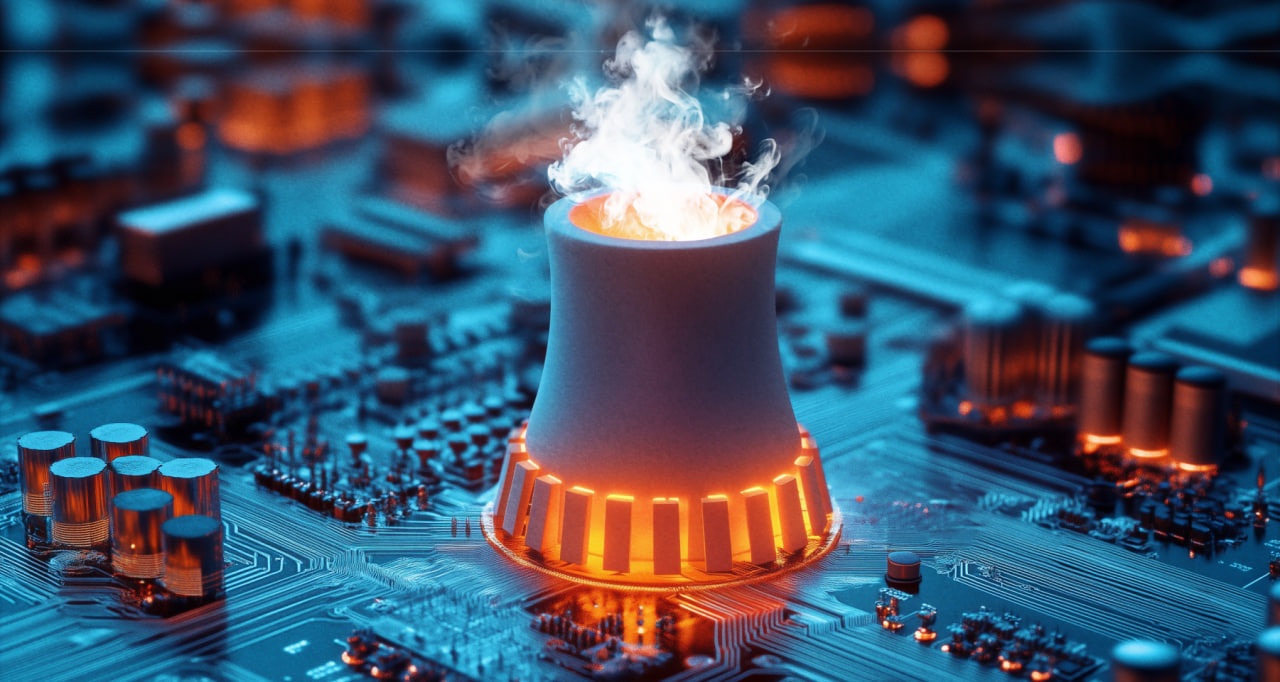Why AI Could Be the Savior of U.S. Nuclear Power

The struggling U.S. nuclear energy industry is getting a second chance. Key figures in Washington and Silicon Valley recognize nuclear power plants as a vital solution to meet the energy demands of data centers that are fueling the AI revolution.
On this page
U.S. Nuclear Energy: A New Era
Electricity consumption in the U.S. is surging after 15 years of stagnation, driven by data centers (DCs) and new manufacturing facilities. Everyday Americans are also contributing to this growth as they shift to electric vehicles and increase air conditioner usage due to rising temperatures.
Despite the rise in demand, nuclear energy’s share in the U.S. energy mix has remained flat. For more than 30 years, nuclear power plants have generated no more than 20% of the nation’s electricity.
The construction of new nuclear facilities essentially stopped in 1979 after a partial meltdown at one of the reactors at the Three Mile Island Nuclear Generating Station (Middletown, Pennsylvania).
Fortunately, the radioactive emissions were minimal and did not cause significant harm to human health or the environment. However, the incident, regarded as the most serious accident in U.S. commercial nuclear energy, brought investments in nuclear power to a halt.
However, recent incentives from President Joe Biden’s Inflation Reduction Act, along with a bipartisan infrastructure law, are set to revive the nuclear energy industry.
Related: Nuclear-Powered AI: The Shape of the Future
In a recent memo, the U.S. Department of Energy outlined plans to revive the country’s nuclear industry. Analysts predict that demand for electricity from data centers alone will increase to 25 GW by 2030.
The Department of Energy sees placing energy-intensive data centers near existing nuclear power plants as an ideal solution. This approach would reduce the need for expensive and large-scale power grid upgrades.
Additionally, the department notes that Congress tends to prioritize funding for road construction and repairs over upgrading the energy infrastructure in the U.S.
We need more investment on a regular basis, not just a one-off grant basis, so I think Congress should think about that going forward
said Energy Secretary Jennifer Granholm.
AI and Microsoft Revive the Three Mile Island Nuclear Generating Station
In an unexpected turn, Microsoft and Constellation Energy have signed an agreement to bring the iconic Three Mile Island Nuclear Generating Station back online.
Three Mile Island Nuclear Generating Station Source: Constellation Energy
Microsoft is seeking additional energy sources to power its data centers, and Constellation Energy has agreed to restart one of the reactors at its Pennsylvania nuclear facility.
The company plans to invest $1.6 billion to restore the reactor.
Under the 20-year contract, Microsoft will ensure full utilization of the 835 MW reactor, which has been idle since 2019. This reactor is located near the one involved in the infamous nuclear incident.
The deal is a major milestone in Microsoft's efforts to help decarbonize the grid in support of our commitment to become carbon negative
said VP of Energy Bobby Hollis.
The restart of the nuclear facility requires approval from the Nuclear Regulatory Commission. The companies are also waiting for permits from state and local authorities, as they expect opposition from environmental groups.
This is not the only nuclear energy initiative connected to Microsoft. In addition to large energy companies working to restart existing facilities, innovative startups are exploring new nuclear technologies.
One of these projects, TerraPower, led by Bill Gates, is exploring the possibility of building a sodium-cooled fast reactor in Wyoming. The startup has already secured support from the U.S. Department of Energy.
OpenAI and Sam Altman Enter the Nuclear Energy Race
In September 2024, OpenAI submitted a proposal to the White House to build a large number of new data centers across the U.S. Each of these centers is expected to consume around 5 GW of power.
To put that into perspective, each facility would use as much electricity as five nuclear power plants.
If Altman’s proposal is approved by government officials, the plan could involve building new nuclear power plants or reactivating older facilities.
Altman is also backing the nuclear startup Oklo, which has secured support from the U.S. Department of Energy. The project team has already reached an agreement with the department and is awaiting inspections at the Idaho site where Oklo plans to construct its own nuclear reactor.
Other tech giants, including Google, are also exploring the potential of nuclear energy, with growing interest from the U.S. government as well.
Recently, the Department of Energy approved a $1.5 billion loan to restart the Palisades Nuclear Power Plant in Michigan, which had been previously decommissioned.
If successful, Palisades would become the first U.S. nuclear plant to resume operations with federal support.
Nuclear energy seems to have bipartisan backing, as it’s gaining support from leaders across the political spectrum.
This was emphasized recently by U.S. presidential candidate Donald Trump:
For AI you will need…more electricity than we have right now,” Trump said. “You'll need double the energy that we produce right now just for that one industry if we're going to be the big player
The content on The Coinomist is for informational purposes only and should not be interpreted as financial advice. While we strive to provide accurate and up-to-date information, we do not guarantee the accuracy, completeness, or reliability of any content. Neither we accept liability for any errors or omissions in the information provided or for any financial losses incurred as a result of relying on this information. Actions based on this content are at your own risk. Always do your own research and consult a professional. See our Terms, Privacy Policy, and Disclaimers for more details.


























